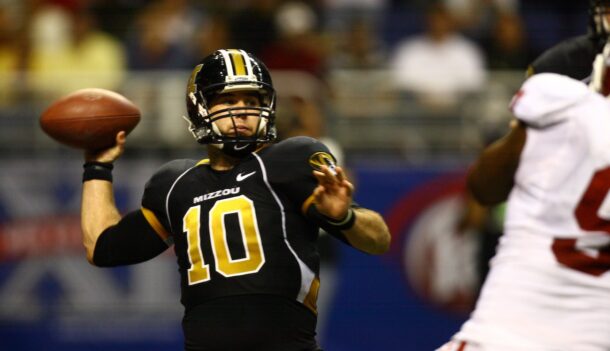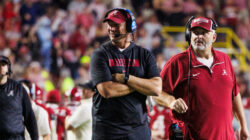
The 5 SEC teams that are in much better shape now than when they started the 2010s decade
So much can happen in a decade. As we come to the last season of the 2010s, that subject is worth digging deeper into.
Take South Carolina for example.
In the 2010s, the Gamecocks had their best 3-year stretch in program history, they fell to the basement of the SEC and watched Steve Spurrier leave the program in shambles, only to have Will Muschamp rebuild it into … almost exactly where they started the decade. That is, as a middle-of-the-road SEC team that can’t seem to take down the big boys.
For other SEC programs, though, there have been major shifts since we flipped the calendar to 2010. Some were good, and some were not.
Today, let’s focus on the good. By “good,” I mean that these programs have a much more optimistic outlook now than when 2010 began.
5. Vanderbilt
Bobby Johnson’s last season in Nashville was one of the SEC’s worst of the 21st century. A winless mark in conference play in 2009 was a tough way to close things out, but even worse was the fact that a 2-win season yielded just 1 win against an FBS opponent (2-win Rice). The Commodores didn’t surpass 16 points in a single SEC game, either.
The frustrating thing was Johnson’s retirement came in July of 2010, which meant the program couldn’t really conduct a coaching search. Robbie Caldwell was an internal hire who ultimately couldn’t do much to turn around the Commodores’ status as an SEC cellar dweller.
But the good that came of Vanderbilt’s woeful start to the decade was that it led to the hiring of James Franklin in 2011. Franklin elevated the job so that a popular candidate like Derek Mason could take it over. Vandy has been to a bowl game in 2 of the past 3 years and the stadium is finally getting the financial support it needs to sustain at least a little more success in the SEC.
That’s a whole lot better than going winless in conference play.
4. Mississippi State
The 2009 season was indeed Dan Mullen’s first, but at the time, we didn’t know that he’d become the most impactful coach in the program’s rather lackluster history (relatively speaking compared to SEC powers). The Bulldogs won 5 games in Mullen’s first year, which marked the eighth time in 9 seasons that they missed out on a bowl game.
Compare that to now when despite losing a 3-year starting quarterback and 3 of the best defensive players in MSU history via the first round of the NFL Draft, the Bulldogs are still a borderline Top 25 team to start the year. Even though Mullen left Starkville, that’s a huge credit to the job he did in his 9 seasons as the Bulldogs’ head coach.
We’re coming off a season in which 8 wins felt like a disappointment for MSU. That’s the standard Joe Moorhead inherited, and that’s the standard he’s still trying to raise. The recruiting is the most notable difference now compared to 10 years ago. MSU just signed a top 25 class and is in good shape to sign another in 2020.
Mullen did an impressive job elevating the program and getting it to a place where it longer needs to win with just a bunch of overlooked 3-star recruits.
3. Tennessee
This is tricky because if you just go back to Jan. 1, 2010, the Vols were a 7-win team with a young, promising head coach in Lane Kiffin. Year 1 of the Kiffin era wasn’t exactly a “we’re back” season, but he was a splashy hire who promised to restore Rocky Top tradition.
Then USC happened.
The move was made official on Jan. 12, 2010, which basically meant that the Vols went into the decade with an identity crisis in the post-Phillip Fulmer era. They went from having 2 coaches in a 32-year stretch to searching for their third coach in as many seasons. It was a strange punch to the gut for a program as proud as Tennessee to take because Kiffin essentially used it as a stepping stone.
Fast forward to now when once again, Tennessee is entering its second season with someone who became a college head coach for the first time after a promising career as a coordinator (I realize Kiffin was the Raiders’ head coach before Tennessee). But that’s basically where the similarities between Jeremy Pruitt and Kiffin stop. Now, the feeling is that the Vols are back on the rise and ready for a major Year 2 improvement.
By all accounts, Pruitt seems like the stability Tennessee needed to climb out of the Butch Jones dumpster. By the time the decade officially comes to a close at the end of this season, we could be talking about the Vols as the No. 2 team on this list.
2. Kentucky
The casual SEC fan wouldn’t know that Kentucky actually closed the decade with 4 consecutive bowl appearances. But the problem was the Rich Brooks era ended when he announced his retirement in the first week of the 2010s decade. There was a “passing of the torch” feel when the Wildcats promoted Joker Phillips to full-time coach because the move was long expected.
So was there optimism? Sure, but the first coach to ever lead the program to 3 consecutive bowl victories was gone.
That’s a much bigger question mark than now when Kentucky is coming off its best season in 4 decades having just ended the streak against Florida. And even better, Mark Stoops has an extremely incentive-friendly contract that should give Cats fans hope that he’s not in a hurry to leave Lexington.
And besides the fact that Kentucky just had its first winning season in the SEC for the first time in 41 years, it’s also the best 3-year stretch for the program (24 wins) since Bear Bryant was running the show. That’s not a bad place to be.
If Stoops delivers another 8-plus win season, we’ll be talking about him the way we talked about Mullen at Mississippi State.
1. Georgia
Wait, didn’t Georgia win a ton of games from 2000-09? Yep. They won 98 games in that stretch, but they were coming off an 8-win season in 2009. It was the first of the post-Matthew Stafford/Knowshon Moreno era, and if you recall, the following things happened in 2009:
- Scored 10 points in big nonconference headliner at Oklahoma State
- Got demolished by Lane Kiffin-led Tennessee
- Got blown out by Tim Tebow’s Florida squad for second straight year
- Lost to Kentucky … at home
Think about if any of those things happened in 2019. Combine that with the fact that Mark Richt was about to sign his lowest-ranked recruiting class at Georgia, and the Dawgs would start 2010 as a borderline Top 25 team with their worst preseason ranking since Richt’s first season. Even though there were better days ahead for Richt, there had to be some major question marks about whether the team’s title window had closed when that 2008 team that started No. 1 didn’t even finish in the top 10. It didn’t help that the 2010 team finished 6-7 — Georgia’s first losing season since 1996.
Compare that to now. For some, the mindset is “national title or bust” with a team that has the modern version of Stafford and Moreno with Jake Fromm and D’Andre Swift. The new expectation with Kirby Smart is that he’ll sign a top 3 class, win the division and have a chance to play for a Playoff spot in the SEC Championship.
Some might argue that Georgia is in the exact same place it was in 10 years ago. That is, searching for its first national title since 1980. I’d argue that the program — which at least got to a title game in 2017 for the first time since Herschel Walker left — is in significantly better shape to do that than it was when the calendar turned to 2010.
There aren’t many programs that I’d want to have more stock in for the next decade than Georgia. You definitely couldn’t say that 10 years ago.
Connor O'Gara is the senior national columnist for Saturday Down South. He's a member of the Football Writers Association of America. After spending his entire life living in B1G country, he moved to the South in 2015.







